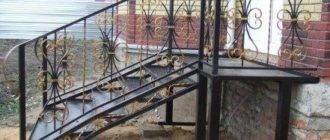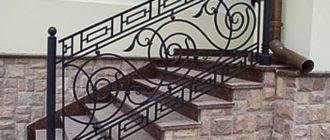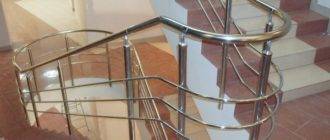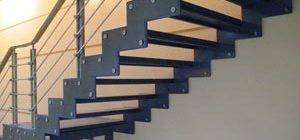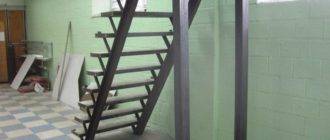A spiral staircase made of metal is far from a new invention. The world is familiar with forged masterpieces of the Baroque and Art Nouveau times, decorated with openwork elements, stairs in the towers of temples and minarets.

It was with the advent of the Art Nouveau style that such designs began to be used in the interior of residential buildings, often making them the most significant, central design element.
Types of metal spiral staircases
In the classical design, spiral staircases made of metal are a central support pillar, around which there are steps. But they can differ from each other in design and manufacturing method.
Manufacturing methods
The manufacture of any metal product involves the use of different materials and methods of processing them.
In this regard, the described structures can be divided into four types:
- Wrought iron - made of steel by art forging;

- Cast – cast iron, less often - from bronze or brass;
- Welded stairs - the most affordable and common;
- Prefabricated - products assembled on site from prefabricated elements made of chrome-plated metal or aluminum. They can be standard or made to order.

The first two types are distinguished by their original, unique design, respectable appearance, but the price of such products is quite high. Welded structures are easy to manufacture, affordable and also very diverse. Welded stairs can be made by hand.
For reference. Metal is often only used to make a structural frame that can be veneered with wood, stone, or other decorative materials.
Design features
Metal spiral staircases always have a central pillar, which serves as a support for fastening the steps.
But the type of attachment can be different.
- On sleeves and bolts. Sleeves are cylindrical sections of pipe, the diameter of which is greater than the diameter of the support. They ensure the fixation of the steps on the central post at a given height. Bolts are installed between the steps along the outer radius, connecting them to each other. Railing posts are installed on the other edge of the step.
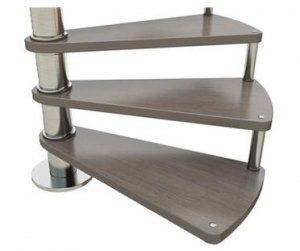
- On the outer string. The steps of such ladders along the outer radius are attached to a spiral bowstring.
- On the console. For those who want to make a ladder with their own hands, this is the easiest option. Consoles are metal beams that only support the B-pillar on one of their sides. They are usually welded to it. In this case, the console itself can serve as a step or only be the basis for it.

- On the supporting walls. If the staircase is located in a bay window or in the corner of the room, this makes it possible to secure the steps most reliably: one side to the central post, and the other to the walls. In the supporting walls, grooves are either arranged, or overlays are attached to them.
How to make a spiral metal staircase
Working with metal is much more difficult than working with wood - you need not only experience, but also special equipment and tools. If this is not a problem for you, and you are familiar with welding work firsthand, then our instructions will help you make a solid and reliable ladder yourself.
Of course, first you need to make measurements, calculations and make a drawing of the future structure in order to know the distance between the steps and their number, to determine the shape of the treads and the type of fastening.
Consider the process of making a ladder on the bolts.
To do this, you will need a thick-walled pipe with a length equal to the distance between floors, a pipe for making sleeves of a larger diameter and the same length, steel corners and a pipe of small diameter for making bolts.
- Cut a large diameter pipe into segments of the same length, equal to the lifting height by one step;
- Try on the resulting sleeves to the center support. If they do not fit tightly, with slots and gaps, you need to weld O-rings made of wire of suitable thickness inside the sleeves and grind the welding places;
- Make a step template from wooden slats by screwing them to a sheet of plywood or chipboard;
- Cut the steel corners into segments equal to the internal dimensions of the template, put them inside and weld them together;

- Weld the frame of the step to the sleeve, clean out all welds;
- String all sleeves with welded steps onto the bearing support and install it in place;
- Set all the steps to a predetermined position, then weld the sleeves together and weld the bolts to the steps, pre-cut from corners or pipes.

At the end of the welding and installation work, the frame must be primed and painted, and the steps must be veneered with wood.
For reference. You can immediately weld finished metal steps to the sleeves. They should be profiled to prevent slipping and stiffened to ensure strength.
Selection and manufacturing tips
Despite the fact that screw designs are considered the most optimal for installation in confined spaces, you should still try to ensure that their characteristics meet the requirements for safety and comfortable use.
This means that the width of the flight of stairs should be sufficient not only for movement, but also for carrying oversized objects. A spiral staircase with a diameter of 100 cm and less does not meet these conditions, since the width of the march in this case will be less than half a meter. Therefore, it can only be installed as an auxiliary and rarely used - for lifting to the attic or descending into the basement.
You should also choose the right angle of inclination. If it is more than 45 degrees, it will be unsafe to use the ladder, and you will have to descend from it with your back forward.
It is imperative to provide a railing, even if the steps are built into the wall with a wide end, otherwise it will be difficult for children and the elderly to go down and up.
Do not use plasterboard and other fragile materials as support walls. And the steps must be lined with non-slip materials, or special corrugated linings must be stuffed on them.
Conclusion

ST three-knee ladder - design features "href =" https://flwn.imadeself.com/33/osobennosty/73-trehkolennaya-lestnica "> about the advantages of a three-knee ladder).
In the video in this article, you will find visual information on this topic.

